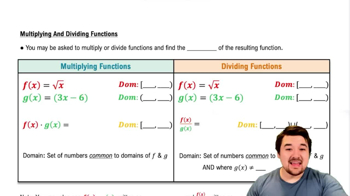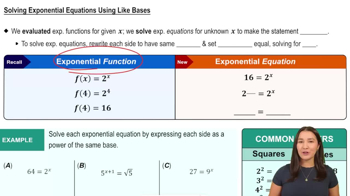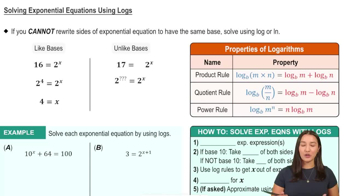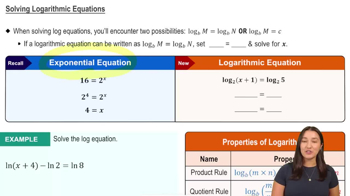Table of contents
- 0. Functions7h 52m
- Introduction to Functions16m
- Piecewise Functions10m
- Properties of Functions9m
- Common Functions1h 8m
- Transformations5m
- Combining Functions27m
- Exponent rules32m
- Exponential Functions28m
- Logarithmic Functions24m
- Properties of Logarithms34m
- Exponential & Logarithmic Equations35m
- Introduction to Trigonometric Functions38m
- Graphs of Trigonometric Functions44m
- Trigonometric Identities47m
- Inverse Trigonometric Functions48m
- 1. Limits and Continuity2h 2m
- 2. Intro to Derivatives1h 33m
- 3. Techniques of Differentiation3h 18m
- 4. Applications of Derivatives2h 38m
- 5. Graphical Applications of Derivatives6h 2m
- 6. Derivatives of Inverse, Exponential, & Logarithmic Functions2h 37m
- 7. Antiderivatives & Indefinite Integrals1h 26m
0. Functions
Exponential & Logarithmic Equations
Problem 1.8
Textbook Question
Use the graph of ƒ to find ƒ⁻¹ (2),ƒ⁻¹ (9), and ƒ⁻¹ (12) <IMAGE>
 Verified step by step guidance
Verified step by step guidance1
<strong>Step 1:</strong> Understand the concept of an inverse function. The inverse function \( f^{-1} \) of a function \( f \) is a function that reverses the effect of \( f \). If \( f(a) = b \), then \( f^{-1}(b) = a \).
<strong>Step 2:</strong> Identify the values of \( y \) for which you need to find the inverse: \( f^{-1}(2) \), \( f^{-1}(9) \), and \( f^{-1}(12) \). This means you need to find the \( x \)-values such that \( f(x) = 2 \), \( f(x) = 9 \), and \( f(x) = 12 \).
<strong>Step 3:</strong> Examine the graph of \( f \) to locate the points where the function value (\( y \)-value) is 2, 9, and 12. For each \( y \)-value, find the corresponding \( x \)-value on the graph.
<strong>Step 4:</strong> For each \( y \)-value, note the \( x \)-coordinate of the point on the graph where the function value is equal to that \( y \)-value. This \( x \)-coordinate is the value of the inverse function at that \( y \)-value.
<strong>Step 5:</strong> Write down the results: \( f^{-1}(2) \), \( f^{-1}(9) \), and \( f^{-1}(12) \) as the \( x \)-values you found in the previous step.
Recommended similar problem, with video answer:
 Verified Solution
Verified SolutionThis video solution was recommended by our tutors as helpful for the problem above
Video duration:
3mPlay a video:
Was this helpful?
Key Concepts
Here are the essential concepts you must grasp in order to answer the question correctly.
Inverse Functions
An inverse function reverses the effect of the original function. If a function f takes an input x and produces an output y, then its inverse f⁻¹ takes y as input and returns x. Understanding how to find inverse functions is crucial for solving problems that require determining specific outputs from given inputs.
Recommended video:

Inverse Cosine
Graph Interpretation
Interpreting graphs involves analyzing the visual representation of functions to extract information about their behavior. For inverse functions, this means identifying points on the graph where the output corresponds to the desired input values. This skill is essential for accurately finding values of f⁻¹ from the graph of f.
Recommended video:

Graphing The Derivative
Function Notation
Function notation is a way to denote functions and their inverses clearly. For example, f(x) represents the output of function f for input x, while f⁻¹(y) denotes the input that produces output y in the inverse function. Familiarity with this notation is important for correctly interpreting and solving problems involving functions and their inverses.
Recommended video:

Multiplying & Dividing Functions

 4:46m
4:46mWatch next
Master Solving Exponential Equations Using Like Bases with a bite sized video explanation from Callie
Start learningRelated Videos
Related Practice




